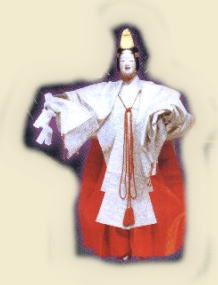
On the 30th of July, in the strong wind of approaching Typhoon #6 , at the historical site of Nagoya Castle,
which is located in the suburbs of Karatsu,
Noh play was performed by Bunzo Otsuki, Sensaku Shigeyama, and Nobutaka Saito.
Nagoya castle was the fort from which thousands
of warriors set sail to Korea and China about
400 years ago, to fight two impossible wars
against the Chinese Empire, only because
of Toyotomi Hideyoshi's irrational ambition.
The continued attacks could not even scratch
the Chinese Empire, but they damaged too
seriously the lands and the people of Korean
Peninsula through which the army progressed.
The wars left thousands of unhealed scars
on the battlefields, and there still remains
deep grief and wrath in the hearts of the
people of Korea.
It is said that Hideyoshi entertained himself
and his Samurais with Noh plays and tea ceremonies
from time to time during the period of the
wars. It was proved that the Golden Tea House
really existed, and a little while ago the
researchers found that Hideyoshi had an island
built in the middle of the pond in the castle
site. There, he must have had a picnic or
boating or something like our modern outdoor
fun.
Every summer, Noh is played here on an outdoor
stage specially built for this purpose, in
the light of burning firewoods. It has some
important meaning for the relationship between
Korea and Japan.
400 years ago, it was probably meant to be
an entertainment for the warriors, or to
heighten their morale, or might be dedicated
to the war-gods to lead them to a victory.
But now, Noh of Nagoya Castle Site means
a completely different thing . It is meant,
I presume, to comfort the souls of the victims
of the wars, and also to pray for the eternal
peace between the two parties.
Master Otsuki and Master Shigeyama, such
important characters in the contemporary
Noh world, are returning guests of Yoyokaku,
to our great honor.
They are also Takashi Nakazato's good friends,
and Takashi is so generous to offer his friends
a chance to see Noh at his house. Each year
in early September, on the turf of Takashi's
studio in Mirukashi, Karatsu, Master Otsuki
plays Noh, Master Shigeyama performs
Kyogen, and Mr. Fujita's sharp sound of the
bamboo flute cuts the moist air of late summer
night into two, and when Mr. Okura's tense
palm claps the small hand drum, the sound
crawls up through the crevasse of the air
and echoes five seconds later from the far
top of the mountain behind the kiln . It
is just overwhelming, and it doesn't seem
real. It might be a Late Summer Night Dream!
Are you surprised if I say I believe in the
Spirits of the land? I do, because
I am that type of Japanese woman, and I am
more than sure that the Spirits are pleased
with this offering of Noh performance. I
believe that the Spirits of the victims of
the wars of Hideyoshi would accept the condol ences and regrets of their far descendants
when Master Otsuki moves his sleeves gravely
in a symbolized way of expressing sorrow. ences and regrets of their far descendants
when Master Otsuki moves his sleeves gravely
in a symbolized way of expressing sorrow.
The flower you see on the right is the National
Flower of Korea, a kind of Hibiscus called
Mugunghwa, of which the Chinese characters
mean 'Eternity' or 'Infinity'.
Mugunghwa flowers bloom in the morning and
die in the evening. It lasts only one day,
but the next dawn other flowers gracefully
open their eyes and they flourish during
the long summer.
In this flower we feel the prayer of Korean
people, and I hope Japanese minds will join
in the wishes when they look up at the noble
Mugunghwa flowers.
Thank you for visiting my site , and I hope
to see you again next month. |
| Yours, |
|
 |
| Mail to Harumi Okochi |
|
|
|

